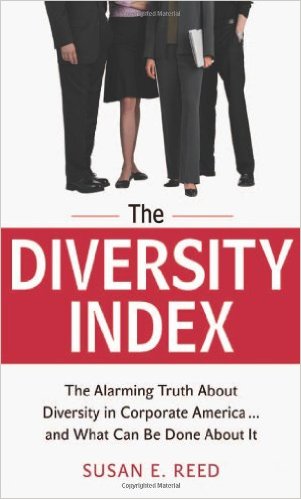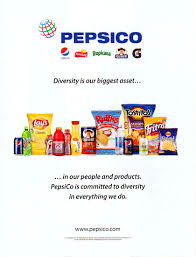Click here to return to Blog Post Intro

In August 2011, Susan E. Reed published The Diversity Index: The Alarming Truth About Diversity in Corporate America…and What Can Be Done About It. This was a thoughtful book about how far we’ve come nearly fifty years after the Great Society’s Civil Rights Act. Reed starts with a few key points about Corporate America’s Fortune 100 companies in 2009:
- Only 6% consisted of entirely white male teams—down from 38% in 1995 and 15% in 2005
- However, nearly 50% employed no African, Asian, Hispanic, or Native American men as executive officers
- 90% had at least one woman in the highest ranks—up from 52% in 1995
- Still, nearly 80% had no minority women in their executive officer ranks
While there is clearly work to be done, by 2009, 60% of the Fortune 100 corporations included minority executive officers in their top tier roles.
Susan Reed’s book offered a couple of case studies from companies that have made great strides to improve their “Diversity Index.” The first example is Merck, the pharmaceuticals development company.

Merck: A Best Practice Case Study
Roy Vagelos was President & CEO then Chairman for Merck in the mid-1980’s. He used a deliberate strategy to diversify Merck’s executive officer team, which made the company stand out from its competitors. In fact, he even met with a small group of African Americans at Merck to get their perspective on how they were advancing within the company. “I was surprised and saddened to learn that, in their opinion, an African American had to be 15 percent better than a White colleague to be promoted at Merck,” he wrote. “I couldn’t see this from my position at the top of the firm, but I believed them because they were intelligent, credible, sincere people.” Unlike Vagelos, most CEOs never engage in conversations about race or gender with their employees…but getting involved is one of the early processes that has to occur for a corporation to level the playing field.
Largely as a result of Vagelos’ efforts, Merck was the only company in the study of the Fortune 100 with a completely mixed team of white men and women as well as minority men and women by 1995!
At the top of the organization, a dominant strategy focuses on developing and promoting all different types of people in the company. Raymond Gilmartin, President & CEO of Merck from 1994 until 2005, continued with this approach. By the end of his tenure, 79% of Merck’s executive officers were women and minorities—the highest percentage ever reached by any of the Fortune 100 companies in the 14-year study.
Merck also utilized Employee Resource (or Affinity) Groups for Black, Hispanic, Native American & Indigenous Peoples, Asian, Interfaith, Differently Abled, LGBT, Women, and Men. Each group had an executive sponsor from the executive management committee. They each focused on the same four questions:
- What can we do internally to accelerate leadership development and inclusion for members of our group?
- How can we enhance inclusion for our group externally?
- How can we enhance our reputation with customers and our group externally?
- Who are the key stakeholders outside the company that we should have a global partnership with?
Like many companies have found, these groups help remove the sense of isolation and futility that can develop where numbers of minority employees are limited in a given work environment.
In addition, as these groups have developed over the years, they provide an avenue for minorities and women to magnify their voices so that the culture hears them. The study identified a positive correlation between affinity groups and high officer integration—90% of the most integrated companies utilized them.
Many organizations approach diversity defensively—to ward off lawsuits by improving employee relations—instead of harnessing it for their business. But, used as a process within the business, diversity can help companies enhance their overall performance by securing the best talent, learning to grapple with larger employee issues such as fairness, and, in Merck’s case, increasing resilience.

PepsiCo: A Best Practice Case Study
When Rosabeth Moss Kanter published her groundbreaking “Men and Women of the Corporation” in 1977, she described homosocial reproduction as the tendency for people to hire and promote people who come from a similar background, went to similar schools, and share similar political or religious beliefs. By 1995, that practice was evident at PepsiCo. While they previously had demonstrated a commitment to promoting minorities, the results had not risen above the token level. In 1995, the company had no white female or male minority executive officers.
Enter Steven S. Reinemund—a 16-year manager with PepsiCo—as Chairman and CEO in 2001. His core desire was to create an “environment where true greatness can be achieved by valuing people for their differences, strengths, talents and callings that they bring.” By 2005, there were three white females, one Asian female, and two African American males on Reinemund’s 11-person team. Before leaving his role in 2006, PepsiCo’s revenues had grown by $9 billion, net income rose 70%, earnings per share were up 80% and PepsiCo’s market cap exceeded $100 billion.
Practicing inclusion—learning to value people who look different, move in a different way, or have an accent—is an adaptive process in the workplace. In other words, people have to learn to appreciate others; they cannot just be ordered to do so…
The biggest American companies—like Merck and PepsiCo—with the most integrated leadership have worked constantly to get it. Whether they did so out of a determination to get the best talent, were driven by a belief that diversity is better for business, or wanted to create a meritocratic atmosphere, they led by example, which is critical for change.

10 Steps to Success
The companies that most improved their “Diversity Index” took these steps:
- Used a core mantra that fused their diversity goals and ethical principles with their business strategy.
- Created a secure, reliable feedback system through which employees from all over the world could communicate safely and directly to a company executive, expressing their concerns over how they were being treated by other members of the company.
- Provided diversity training to employees and fostered a culture of learning.
- Made managers’ pay contingent on how they were rated and how they developed diverse employees.
- Offered summer internships and contributed to funds that enabled underprivileged students to go to college.
- Developed, supported, and funded extensive affinity groups. They made it mandatory for managers and officers to be involved in these groups. The groups then educated coworkers about cultural differences, developed wide networks, learned leadership, and developed new business strategies to reach out to untapped domestic and foreign markets.
- Invested in local communities to improve public school education and opportunities.
- Promoted women and people of color.
- Had Chief Executives who opened themselves to negative feedback about what was not working by holding regular meetings with managers and employees.
- Never stopped trying new ideas to foster integration.
It’s my hope that we’re moving toward Lyndon B. Johnson’s vision for a “Great Society.” After all, that’s what I want to be part of, as I shoot for the stars!

